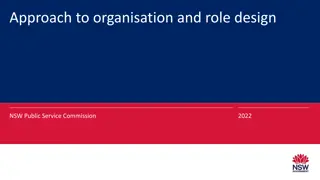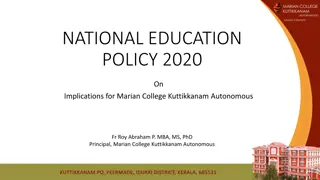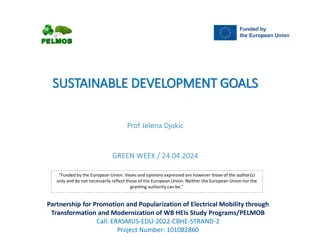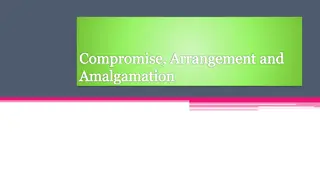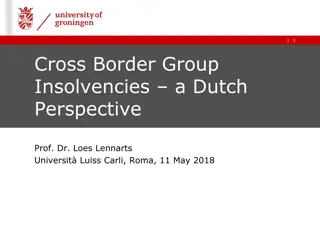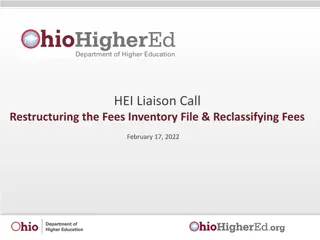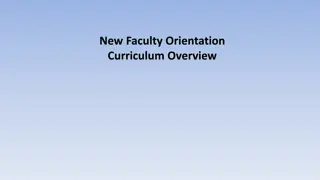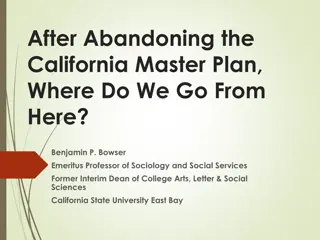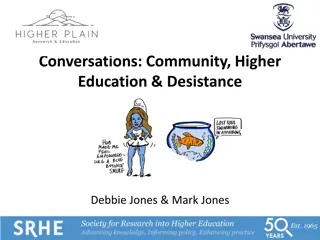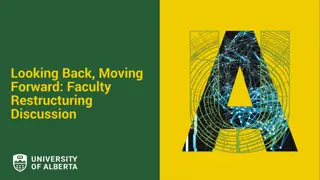Challenges Faced in Higher Education Restructuring: A Case Study
In this case study, the impact of restructuring in higher education at Essex University is explored, focusing on the changes in provision, skills development, and institutional context. The challenges faced post-restructuring include reduced resources, limited scope for embedded teaching, and cuts in services, all against the backdrop of increasing centralization and expansion. The before-and-after comparison highlights the significant transformations in credit modules, assessment opportunities, and student support.
Download Presentation

Please find below an Image/Link to download the presentation.
The content on the website is provided AS IS for your information and personal use only. It may not be sold, licensed, or shared on other websites without obtaining consent from the author. Download presentation by click this link. If you encounter any issues during the download, it is possible that the publisher has removed the file from their server.
E N D
Presentation Transcript
Building Networks and Building Networks and Embedding EAP Embedding EAP Conceptualising Conceptualising Status and Withstanding Status and Withstanding Upheaval Upheaval Dave Rush University of Essex
Todays talk Overview of provision at Essex Impact of restructure and ongoing instability What we ve learnt: Skills for all Building networks Conceptualising status 2
Skills for Success In-sessional academic skills and EAP all departments, all levels Use CEM model as our starting point 3 broad strands of provision: embedded teaching Academic English Support (ie. EAP) Central services 1:1s and workshops 3
2019 restructure 2019 restructure merged with Employability and Careers teams All tutors moved to annualised contracts Workload model imposed no time for scholarship, minimal prep time Status of tutors deliberately undermined 4
Before Before restructure, gold standard = For embedded, credit module or module strand, multiple assessment and feedback opp s For EAP dept specific, highly scaffolded, multiple assessments mapped against dept requirements 5
and after After restructure: All credit modules cut In-house English language test scrapped Scope of embedded teaching limited No marking or assessment allowed 1:1 service cut 6
Institutional context All this against backdrop of: Huge expansion in student numbers Falling entry requirements Decision making increasingly centralised USG 7
Skills for Success Overview of Contact Hours 18/19 19/20 20/21 21/22 22/23 Embedded 1618 1536 1097 1044 1114 AES 960 926 641 739 911 Central 464 209 431 728 974 Total 3042 2671 2169 2511 2999 8
Skills for Success Overview Graph SfS Delivery 3500 3000 2500 2000 1500 1000 500 0 Embedded AES Central Total 18/19 19/20 20/21 21/22 22/23 9
Where did that leave us? More of a support service than an academic department? And yet in many ways situation is improved. Why? Primary remit = to support ALL students Skills network approach Changing perceptions of our identity 10
Supporting all students Not deficit model or remedial Emphasis on ALL, and not on international Changes in students both international and non Idea that home students need EAP/skills support not a new one NOT suggesting no EAL support 11
Establishing a skills network Not holding on to territory but welcoming all efforts to support students with skills E.g., all workshops listed as academic skills , whether us, Library, IT, SWIS, int. services, SU Includes academics and PS staff from depts 12
Establishing a skills network - benefits Helps all individuals and teams involved Looks better to SMT Helpful to staff and students easier to signpost and to find support Students don t care who is delivering Helps to withstand upheaval? 13
Perception and identity Cross-disciplinary perspective; experts in analysing conventions, expectations Lecturers increasingly aware of need and that they cannot do this Can be an academic field of study and a support service need to emphasise teaching expertise and nature of the skills classroom 14
Identity Identity for the institution; the students; the academic community and for ourselves EAP/skills teaching as catalyst (bell hooks) Contextualisation is key, but also engagement with context ignorant schoolmaster Not transmission, but doing 15
Where does this leave us? An academic field of study but not an academic department? Both inside and outside a complement, not an add on At the heart of academia concerned always with the doing, with what is happening 16
References Ding, Alex and Bruce, Ian, The English for Academic Purposes Practitioner : Operating on the Edge of Academia, 1st ed. (Springer International Publishing, Cham, 2017). hooks, bell, Teaching to Transgress: Education as the Practice of Freedom, (Routledge, London, 1994). Ranci re, Jacques, The Ignorant Schoolmaster: Five Lessons in Intellectual Emancipation, trans. & intro Kristin Ross, (Stanford Uni Press, California, 1991). Sloan, Diane and Porter, Elizabeth, Changing international student and business staff perceptions of in-sessional EAP: using the CEM model , from Journal of English for Academic Purposes, 9, pp198-210, (2010). 17

 undefined
undefined


 undefined
undefined undefined
undefined


